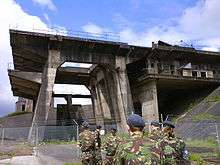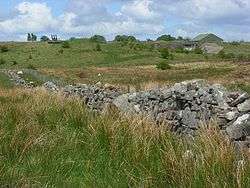RAF Spadeadam
| RAF Spadeadam | |
|---|---|
| Near Gilsland, Northumberland in England | |
|
RAF Spadeadam | |
|
'Si vis pacem para bellum'" (If you seek peace, prepare for war) | |
 RAF Spadeadam Shown within Cumbria | |
| Coordinates | 55°01′30″N 002°36′08″W / 55.02500°N 2.60222°WCoordinates: 55°01′30″N 002°36′08″W / 55.02500°N 2.60222°W |
| Type | Royal Air Force station |
| Area | 7,820 acres (3,165 ha)[1] |
| Site information | |
| Owner | Ministry of Defence |
| Operator | Royal Air Force |
| Site history | |
| Built | 1955 |
| In use | 1957 – present |
| Garrison information | |
| Current commander | Wing Commander R Henderson-Begg |
RAF Spadeadam (IATA: N/A, ICAO: EGOM) is a Royal Air Force station in Cumbria, England close to the border with Northumberland. It is the home of the 9000 acre (36 km2) Electronic Warfare Tactics Range, making it the largest (by area) RAF base in the United Kingdom. Its primary use is for Electronic Warfare (EW) training to the Royal Air Force and NATO allies.[2] The site and course of Hadrian's Wall runs a few miles south of the range.[3]
History
Spadeadam was remote and largely uninhabited until 1955[4] when the Intermediate Range Ballistic Missile Test Centre was built for the Blue Streak Project.[5] The RAF took it over in 1976 and it became Europe's first Electronic Warfare Tactics Range in 1977. The range contains ground-based electronics warfare equipment to act as a simulated threat to training aircrews. Some of the equipment was manufactured in the Soviet Union; some simulates emissions from potential enemy systems. It also has real and dummy targets such as airfields, a "village" of portable buildings, tanks, aircraft and vehicle convoys.
The site's role in Britain's Cold War nuclear weapons programme was made public in 2004 when tree-felling uncovered remains of abandoned excavations for a missile silo. A survey of the site by the RAF and English Heritage has attempted to record and interpret what was previously so secret that no plans from the period exist. Spadeadam was chosen as a launch site because of its isolation combined with nearby infrastructure capable of supporting it with such as a plentiful water supply, access to the National Grid and road connections. A stretch of the road to the site from Gilsland had to be bypassed to make access easier for heavy trucks and the abandoned section is still known as "half-shaft" due to its unfortunate effect on vehicle transmissions. Spadeadam was probably intended to be one of 60 launch sites but these were never built and it was only used as a test facility for engine firings and testing electronics and ground installations.

The Rocket Establishment, as it was called, was divided into five areas: an administration and assembly block, a British Oxygen Company compound for on-site liquid oxygen fuel manufacture, a component test area, the engine test area and the static firing stands.[6]
The engine test area at Prior Lancy Rigg consisted of four concrete stands into which the engines could be mounted for test firing. Three remain, copied from a Rocketdyne design used at their California Santa Susana Field Laboratory site; the fourth has been demolished. This lost stand seems to have been built to a different design, using an innovative application of pre-stressed concrete to contain liquid oxygen spills.
Two rocket-firing stands themselves stood at Greymare Hills and were large enough to accommodate a full Blue Streak missile.[7] All firings were controlled from command centre bunkers connected to the stands by tunnels or surface cabling ducts.
Construction of the site required hundreds of men, mostly Irish labourers who lived in a temporary settlement nearby which locals called 'Paddy's Camp'.
Post missile use
Today the site is used in training the Royal Air Force and NATO allied aircrew in Electronic Warfare (EW). It also hosts other exercising forces such as JFACTSU Forward Air Controller Training delivered from RAF Leeming in North Yorkshire. Close Air Support (CAS) training is carried out too. Since 2006, this has been the only mainland UK location where aircrews can drop practice bombs,[8] though this was suspended between 2008 and 2009 for tree felling.
DNV GL uses the site for industrial hazard testing including fire and the destruction of pipelines. The remoteness of the area is key to their operations.[9]
The outlying moorland landscape of the site is of increasing importance for its visual quality and for nature conservation. The area includes a pristine peat bog, populations of all three species of British newt and forestry habitat suitable for endangered red squirrels.[10] Otters have been noted along the watercourses and still ponds that are dotted across the vast training area.[11] Trees that were planted on the site after the First World War were felled in 2008 to 2009 to allow the peat bogs to return. Despite concerns about trees being 'Carbon Sinks', the rarity of the peat habitat meant the Forestry Commission decided to fell 145,000 trees.[12][13]
References
- ↑ "Estate Baseline 2009" (PDF). 3 July 2009. p. 8. Retrieved 2 October 2016.
- ↑ UK Defence Statistics 2004. London: Ministry of Defence. 2004. p. 119. ISBN 0 11 773020 3.
- ↑ "MoD Heritage Report 2011-2013" (PDF). Ministry of Defence. p. 8. Retrieved 6 July 2016.
- ↑ "MoD Heritage Report 2011-2013" (PDF). Ministry of Defence. p. 6. Retrieved 6 July 2016.
- ↑ "History". Royal Air Force.
- ↑ Historic England. "RAF Spadeadam: Blue Streak Rocket (1413245)". National Heritage List for England. Retrieved 5 July 2016.
- ↑ Historic England. "RAF Spadeadam Greymare Hill Missile Test Area (1580748)". PastScape. Retrieved 5 July 2016.
- ↑ "Close Air Support". Royal Air Force. Retrieved 5 July 2016.
- ↑ "Explosives testing centre to open at Spadeadam". News and Star. 30 June 2016. Retrieved 5 July 2016.
- ↑ "Efforts to protect red squirrels". BBC News. 9 December 2007. Retrieved 5 July 2016.
- ↑ "Cumbria - RAF Spadeadam". Sanctuary. No. 37. Ministry of Defence. 2008. p. 68. ISSN 0959-4132.
- ↑ "Open Country". BBC Radio 4. BBC. Retrieved 5 July 2016.
- ↑ "RAF bombers halted by peat bogs". BBC News. 15 April 2008. Retrieved 5 July 2016.
External links
| Wikimedia Commons has media related to RAF Spadeadam. |
- Official website
- Photos from a Subterranea Britannica visit
- RAF Spadeadam on Multimap.com Priorlancy rocket engine test area Rocket & missile test area at Graymare Hill
- Plans of the Blue Streak K11 missile silo
- GL Noble Denton - Spadeadam Test Site


